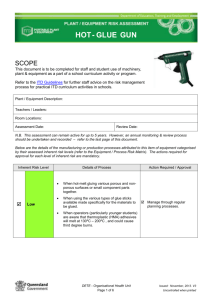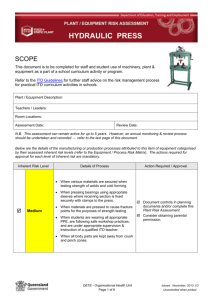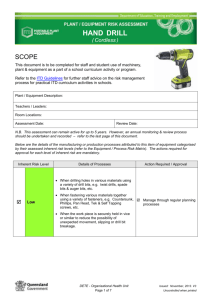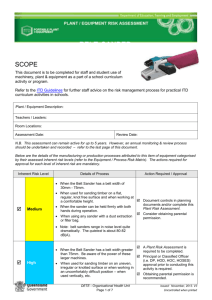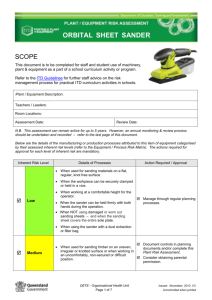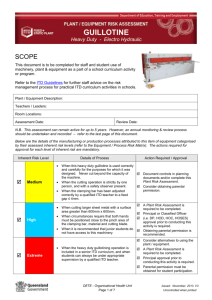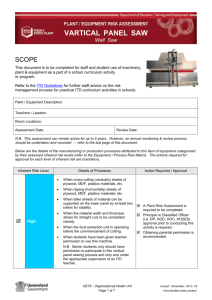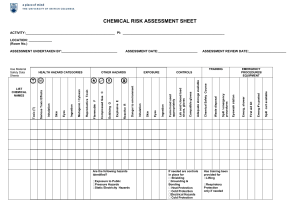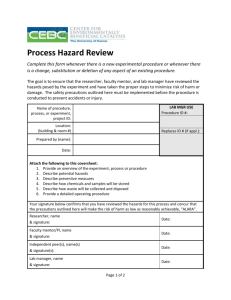DETE - Plant & Equipment Risk Assessment
advertisement
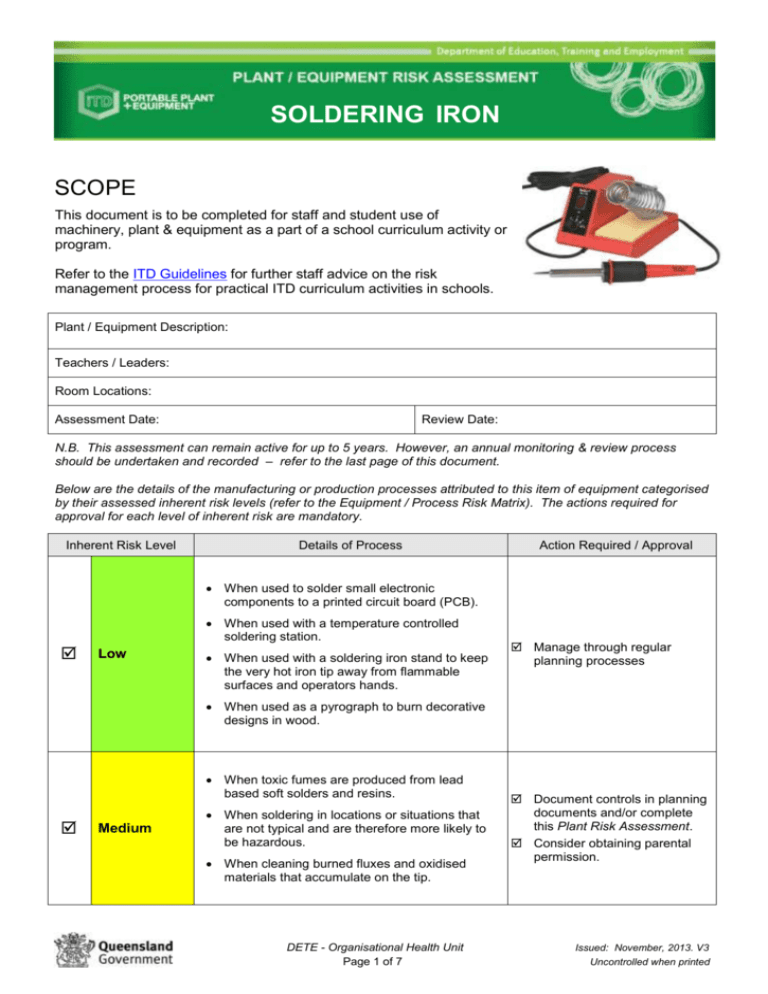
SOLDERING IRON SCOPE This document is to be completed for staff and student use of machinery, plant & equipment as a part of a school curriculum activity or program. Refer to the ITD Guidelines for further staff advice on the risk management process for practical ITD curriculum activities in schools. Plant / Equipment Description: Teachers / Leaders: Room Locations: Assessment Date: Review Date: N.B. This assessment can remain active for up to 5 years. However, an annual monitoring & review process should be undertaken and recorded – refer to the last page of this document. Below are the details of the manufacturing or production processes attributed to this item of equipment categorised by their assessed inherent risk levels (refer to the Equipment / Process Risk Matrix). The actions required for approval for each level of inherent risk are mandatory. Inherent Risk Level Details of Process Action Required / Approval When used to solder small electronic components to a printed circuit board (PCB). When used with a temperature controlled soldering station. Low When used with a soldering iron stand to keep the very hot iron tip away from flammable surfaces and operators hands. Manage through regular planning processes When used as a pyrograph to burn decorative designs in wood. When toxic fumes are produced from lead based soft solders and resins. Medium When soldering in locations or situations that are not typical and are therefore more likely to be hazardous. When cleaning burned fluxes and oxidised materials that accumulate on the tip. DETE - Organisational Health Unit Page 1 of 7 Document controls in planning documents and/or complete this Plant Risk Assessment. Consider obtaining parental permission. Issued: November, 2013. V3 Uncontrolled when printed Minimum Standards Minimum Qualifications and Experience Listed below are the general “Minimum” recommendations for the management of this Plant / Equipment. Indicate the minimum management controls. Registered teachers with experience, ability and competency in the safe use of this plant / equipment (indicate one or more of the following): Specific knowledge of the safe and correct use of this plant / equipment; Experience (i.e. previous involvement and familiarity) in the safe use of this plant / equipment; Demonstrated expertise, ability and competency with this plant / equipment; Documented qualifications relating to the use of this plant / equipment ( e.g. in a staff profile ) OR An adult staff member or leader, other than a registered teacher, with : Expertise in the safe and correct use of this plant / equipment; Documented qualifications that demonstrate experience, ability and competency in the safe use of this plant / equipment. Will any ITD staff require initial and/or ongoing training for the safe use of this plant / equipment ? If yes, give details: Will students be operating this plant / equipment ? If yes, state how student use of this plant / equipment will be managed ( e.g. Workshop Safety Induction ) Give details: Further information if required: Minimum Control Requirements Supporting documentation available in the school on this plant / equipment includes: Operators Manual Safe Operating Procedures – (SOP) Equipment Maintenance Records – (EMR) A process for recording student safety induction ( link to example ) A process for recording staff training & experience – e.g. ITD Staff Profile ( link to example ) All guards are in place & in good working order for this plant / equipment Safe Working Zones are defined for this plant / equipment (e.g. yellow lines and / or appropriate signage) Suitable personal protective equipment (PPE) is available to be used by all operators This plant / equipment complies with relevant safety standards Further information if required: DETE - Organisational Health Unit Page 2 of 7 Issued: November, 2013. V3 Uncontrolled when printed Hazards and Control Measures Listed below are indicative hazards/risks and suggested control measures. They are by no means exhaustive lists. Add details of any other hazards/risks or additional controls you intend to implement. Indicate the Control Measures adopted. Detail their implementation and any additional controls required. Hazards/Risks Slips, Trips, Falls & Abrasions: Can anyone using the plant or in the vicinity of the plant, slip, trip or fall due to the working environment or other factors? e.g. Poor housekeeping, dust on floors, slippery or uneven work surfaces, power cables across work areas causing injuries & abrasions? Environmental: Fumes & Vapours Is it likely there will be airborne dust particles, toxic fumes or volatile vapours produced & therefore be present in the workspace? Lighting Is there insufficient lighting to operate this plant in a safe manner? Is there a possible strobe lighting effect caused by faulty fluorescent tubes in the workspace? Hierarchy of Recommended Control Measures Yes No Details of how this will be implemented ( and any additional controls ) 1. Slip resistant flooring is encouraged. Regular checks are made for unsafe wear & damage. Inspections are made for any power leads, etc. 2. Procedures are in place for the disposal of all waste materials around areas or work stations where electric soldering irons are being used. 3. Staff training is provided to minimise exposure to these hazards. 1. All portable soldering irons are regularly inspected & maintained to help minimise the risk of exposures to these hazards. 2. All portable soldering iron maintenance is documented. 3. Staff & student training is provided to minimise exposure to these hazards. 4. Adequate ventilation to prevent fumes from breathing zone eg. open area with good cross ventilation; fume extraction system. 5. All ducted fume extraction systems are connected and operational, fully maintained and cleaned as required. 6. Good lighting is provided to all workspaces and this is maintained on a regular basis. Fluorescent tubes are checked & replaced as required. 7. All approved personal protective equipment (PPE) is used where required. Electrical: Can the operator be injured by electrical shock due to working near or contacting with damaged or poorly maintained live electrical conductors such as power outlets, extension leads, safety switches, starters & isolators or casual water on the floor near plant & machinery? 1. Visual checks are made of all portable power tools, their electrical switches, plugs & power leads, etc. 2. Electrical safety inspections, testing & tagging, etc. are completed regularly as per guidelines for all portable power tools. 3. Portable power tools are to be used only where there is a RCD safety trip switch connected. 4. Warning “Danger” tags (or similar) are affixed to all portable power tools under repair or maintenance preventing workers from using them. 5. Electrical maintenance on all portable power tools is documented. DETE - Organisational Health Unit Page 3 of 7 Issued: November, 2013. V3 Uncontrolled when printed Hazards/Risks Exposure: Heat, Burns & Scalds Could the plant operator be exposed to a heating element, exposed flame, flashback, molten metals or hot fluids likely to cause scalding or burning? Hazardous Substances Is it likely that the plant operator or others nearby in the workspace could be exposed to hazardous or toxic chemicals such volatile vapours, fumes or airborne particulates? Hierarchy of Recommended Control Measures Yes No Details of how this will be implemented ( and any additional controls ) 1. Non-lead solder is used where appropriate. If lead based solder is used, provide appropriate controls to manage (refer to SOP). 2. Any potentially hazardous waste materials or toxic vapours resulting from this soldering process are monitored and managed. 3. Staff & student training is provided to minimise exposure to these hazards. 4. “Safe Working Zones” or dedicated soldering stations are clearly defined in the workspace. 5. Particular emphasis is placed on the requirement for operators to be warned and to be cautious of the very hot temperatures generated at the soldering tip. Insulated soldering irons stands are recommended for all workstations. 6. All approved personal protective equipment (PPE) is used where required eg. appropriate gloves. Ergonomics & Manual Handling: Can the plant be safely operated, in a suitable location, providing clear & unobstructed access? Poorly designed work stations often necessitate teachers & students performing manual tasks involving heavy lifting & lowering, pushing, pulling or carrying, etc. Such tasks then contribute to a range of musculoskeletal sprains & strains for workers. Explosion & Fire: As a consequence of using this particular item of plant & equipment, could anyone be injured by the release of stored energy triggered by volatile, explosive substances such as stored gasses, vapours or liquids? 1. Where possible, practical work benches & soft soldering workstations are planned & adjusted to a comfortable work height thus minimizing any unsafe or excessively strenuous manual tasks. 2. Sufficient workspace is provided in all practical classrooms to help ensure unobstructed, safe operation. 3. Floors are regularly cleaned & free of excessive wood dust, waste materials & other extraneous objects. 4. Staff training is provided with regard to manual handling techniques & procedures to minimise exposure to these hazards. 1. Fire extinguishers of the correct type are readily available in all workspaces & positioned near exit doorways. 2. Staff training is provided regarding procedures for the correct & appropriate use of fire safety equipment. 3. Exits from buildings & other work areas are defined & access to them kept clear of obstructions. 4. Safety signage is posted clearly denoting the location of all fire safety items & emergence exits. DETE - Organisational Health Unit Page 4 of 7 Issued: November, 2013. V3 Uncontrolled when printed Additional Control Measures Other Hazards/Risks These would relate to the specific student needs, locations and conditions in which you are conducting your activity. Approval Submitted by: Date: Approved as submitted. Approved with the following condition(s): Not Approved for the following reason(s): By: Designation: Signed: Date: ITD staff members involved in the use of this risk assessment & the associated plant & equipment: Signature: ……………………………….. Date: Signature: ……………………………….. Date: Signature: ……………………………….. Date: Signature: ……………………………….. Date: Signature: ……………………………….. Date: Signature: ……………………………….. Date: Signature: ……………………………….. Date: Signature: ……………………………….. Date: DETE - Organisational Health Unit Page 5 of 7 Issued: November, 2013. V3 Uncontrolled when printed DETE - Organisational Health Unit Page 6 of 7 Issued: November, 2013. V3 Uncontrolled when printed Monitoring and Review This Plant & Equipment Risk Assessment is to be monitored and reviewed annually for a further four (4) years Review 1: Yes No Are allocated risk levels and “Actions Required” unchanged over the past 12 months ? Are Minimum Standards and Recommended Control Measures unchanged over 12 months ? ITD staffing details at this school have remained unchanged over the past 12 months ? If the responses are “NO” for any question, record current details here, and list all staff changes (with signatures) Reviewed by: Designation: Signed: Review Date : Review 2: Yes No Are allocated risk levels and “Actions Required” unchanged over the past 12 months ? Are Minimum Standards and Recommended Control Measures unchanged over 12 months ? ITD staffing details at this school have remained unchanged over the past 12 months ? If the responses are “NO” for any question, record current details here, and list all staff changes (with signatures) Reviewed by: Designation: Signed: Review Date : Review 3: Yes No Are allocated risk levels and “Actions Required” unchanged over the past 12 months ? Are Minimum Standards and Recommended Control Measures unchanged over 12 months ? ITD staffing details at this school have remained unchanged over the past 12 months ? If the responses are “NO” for any question, record current details here, and list all staff changes (with signatures) Reviewed by: Designation: Signed: Review Date : Review 4: Yes No Are allocated risk levels and “Actions Required” unchanged over the past 12 months ? Are Minimum Standards and Recommended Control Measures unchanged over 12 months ? ITD staffing details at this school have remained unchanged over the past 12 months ? If the responses are “NO” for any question, record current details here, and list all staff changes (with signatures) Reviewed by: Designation: Signed: Review Date : DETE - Organisational Health Unit Page 7 of 7 Issued: June, 2013. V3 Uncontrolled when printed
